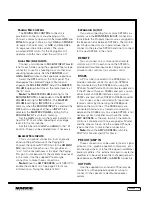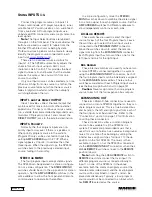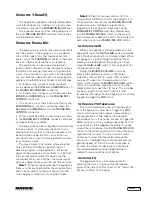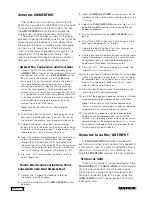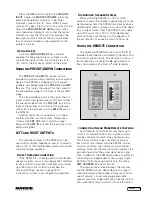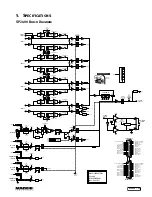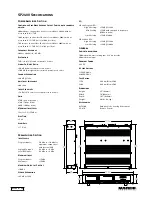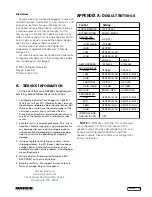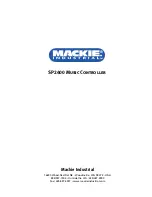
SP2400 – 18
Using INPUTS 1-4
Connect the program sources to Inputs 1-4.
These could include a CD player, tape deck, tuner,
satellite feed, TV audio, jukebox, or an audio feed
from a live band. All four program inputs use
unbalanced RCA connectors and accept stereo line-
level signals.
Note:
The Input Select buttons are labeled 1
through 4 on the front panel. The spaces below the
buttons are sized to accept 1/4" labels from the
Brother P-Touch Electronic Labeling System.
Professional-looking labels can be made to clearly
identify the program source connected to each
input (visit
www.brother.com
).
There are no individual volume controls for
Inputs 1-4. The SP2400 automatically adjusts the
volume for each input using an AGC circuit
(Automatic Gain Control). This provides the best
signal-to-noise ratio and insures that the volume
remains the same when you switch from one
source to another.
Only one Input source can be selected at a time.
When switching from one source to another, the
previous source fades out while the new source
fades in (digital crossfade), rather than abruptly
switching between the two.
INPUT 1 and the Direct OUTPUT
Input 1 provides a direct line-level output that
can be used for music-on-hold or other external
applications. Connect a continuous music source
(i.e., satellite feed, prerecorded background music,
multi-disc CD player) to Input 1 and connect the
DIRECT OUTPUT
jacks to the external destination.
INPUT 4 Priority
Normally, the four program inputs are non-
priority inputs. However, if there is a jukebox or
other priority program source in the system,
Program Priority can be activated on Input 4 by
setting
AMP ADDRESS
switch #7 UP. When a
signal appears at Input 4, it overrides the other
three inputs. When the signal stops, the SP2400
switches back to the previously selected input
source, fading it in smoothly.
STEREO or MONO
The four program inputs accept stereo signals.
The SP2400 can be operated in a stereo configura-
tion or a zone configuration. The
STEREO/MONO
switches should be set to the up position for stereo
operation. Set the
AMP ADDRESS
switches to the
same address to allow the front panel and remote
control panels to operate both amplifiers.
In a zone configuration, move the
STEREO/
MONO
switches down to combine the stereo signal
into a mono signal for each program source. Set the
AMP ADDRESS
switches to different addresses to
allow independent control over each zone.
LOCAL or REMOTE
These switches are used to select the input
source for each of the four Program Inputs. Leave
the switches up to select the local input source
connected to the
PROGRAM INPUT
connector.
Move the switches down to select the remote
signal coming from the
EXPANSION IN
connector.
Each Program Input has two switches, one for the
left input and one for the right input.
Bus Assign
These internal switches are used if you have two
or more SP2400s connected together in a system
using the
EXPANSION IN/OUT
connectors. Each of
the four program inputs can be individually assigned
to the
EXPANSION
balanced bus. There are four
switches associated with each Program Input source
(see the Bus Assign Switch chart on page 13).
Caution:
Never assign more than one program
source to each of the four expansion bus outputs.
EXPANSION IN/OUT
These two 25-pin D-Sub connectors are used to
connect two or more SP2400s together so they can
share program sources. This is a true balanced bus
and transmits the left and right signal from each of
the four inputs over balanced lines. Refer to the
“Connections” section on page 12 for information
on wiring these connectors.
These connections allow a common program
source to be available to all the SP2400s in a
system. For example, prerecorded music that is
used for music-on-hold can also serve as background
music for an entire office building by setting the
internal bus assign switches for Input 1 to the up
position on the first SP2400. The music is then
available to Input 1 on all the SP2400s connected
via the
EXPANSION IN/OUT
connectors when their
LOCAL/REMOTE
switches are set to the
REMOTE
position (down).
Note:
Switching the
LOCAL/REMOTE
switch to
REMOTE
doesn't disconnect the local input. If a
different program source is connected locally to
Input 1 on one of the SP2400s in the above
example, both the common program source (the
remote prerecorded music) and the local program
source will be combined on Input 1 and can be
played simultaneously. Typically, a local program
source would not be connected to an Input which
has
REMOTE
selected as the source.














